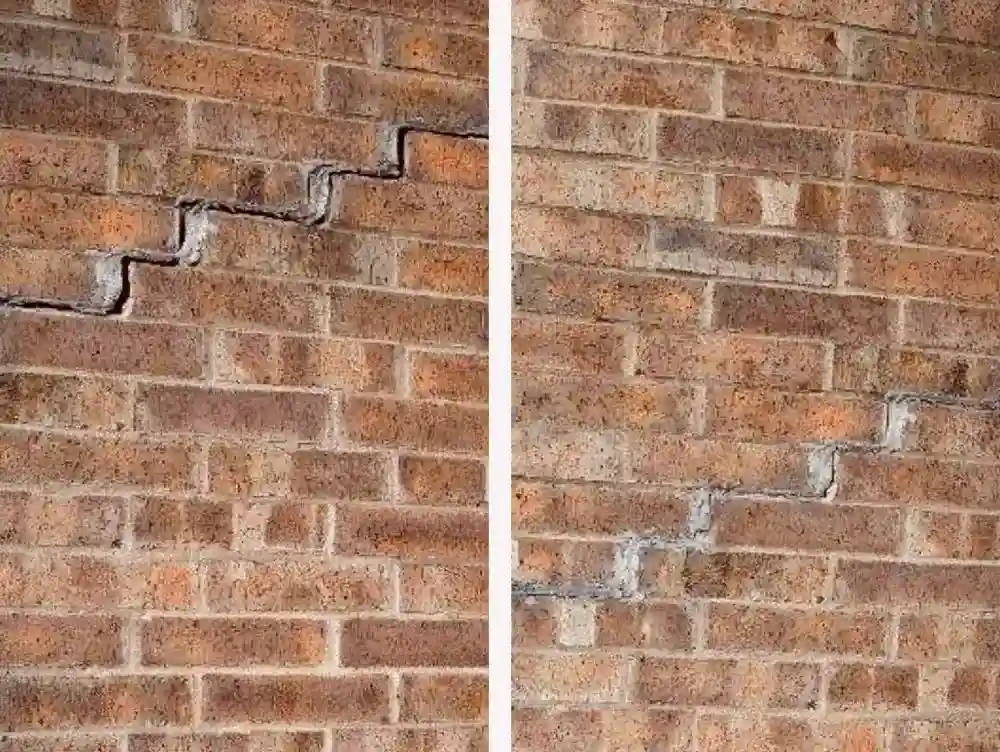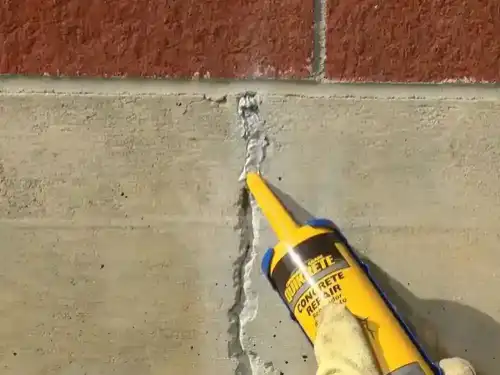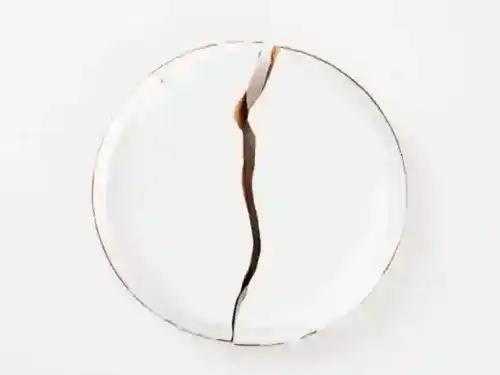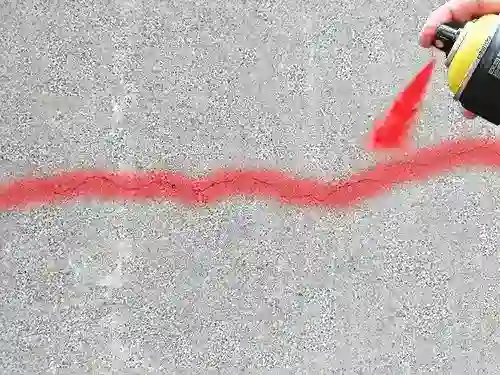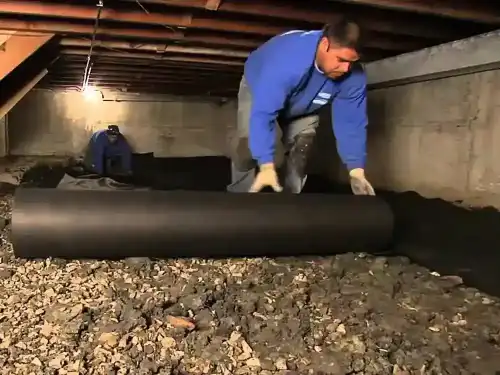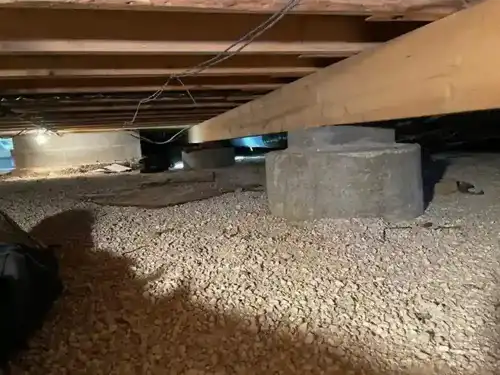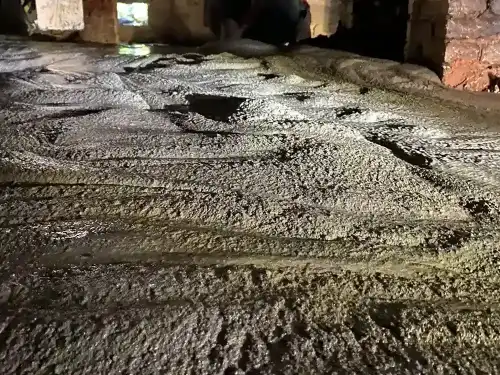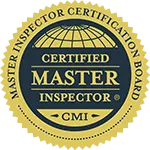Page Contents
- Everything You Want to Know About Foundation Types
- Brick Foundation Types
- Should You Finish Your Brick (or any old) Basement?
- Stacked Stone Foundation Types
- When To Call A Structural Engineer
- Concrete Block Foundation Types
- 4 Ways To Check If A Foundation Crack Is Still Moving
- Concrete Slab Foundation Types
- So, what is the difference between mortar and hydraulic cement?
- Poured Concrete Foundation Types
- Huh? I Have a Crawlspace?
Everything You Want to Know About Foundation Types
There are 5 major areas in every home:
1. Foundation
2. Plumbing
3. Roof
4. Electrical
5. HVAC
These 5 areas make up our Major-Items Inspection and are so important, they get undivided attention at the end of every inspection.
And depending on its age, the foundation of a Kansas City area home will be made from one of these materials:
In this blog post you will learn:
- WHERE you’ll find the various foundation types
- WHEN the different materials were used
- WHAT maintenance each foundation type needs
- WHAT to expect from each type of foundation
- HOW long the foundation material should last
- WHAT types of movement to expect
- WHAT to do when something goes wrong
- WHICH foundation repairs you can make
- WHEN to call a professional
- WHO to call and who NOT to call
- HOW foundations are repaired
- HOW much foundation repairs cost
This will help you understand the different foundation types you’ll see as you shop for a home around Kansas City.
Brick Foundation Types
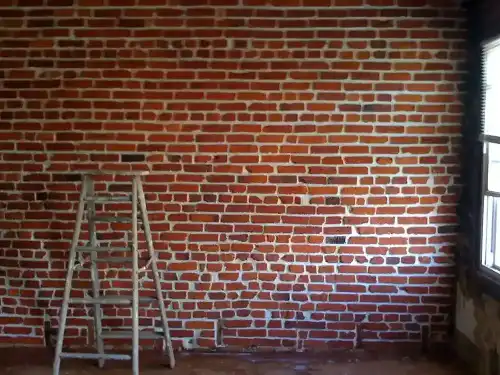
What are brick foundation types made from?
Red brick and mortar
When were brick foundations used?
This is a very early type of foundation.
European homes used brick as early as the 1400s and it was used extensively throughout Kansas City until around 1920 (even longer in rural farmhouses).
How long should brick foundation types last?
100+ years with diligent maintenance.
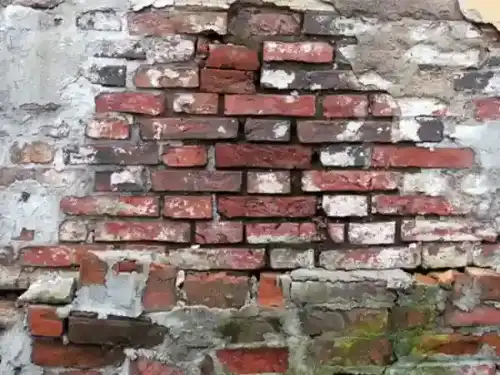
What can I expect from brick foundation types?
A labor of love.
In other words, because of the age and nature of this material, DON’T expect a bone-dry basement or crawlspace.
This foundation is found in rural farm homes along with the oldest homes in the most mature neighborhoods of Kansas City.
And with all its charm, there comes a commitment to keeping the past alive.
Because red bricks and mortar are porous and absorb moisture so they will deteriorate and eventually disintegrate into powder.
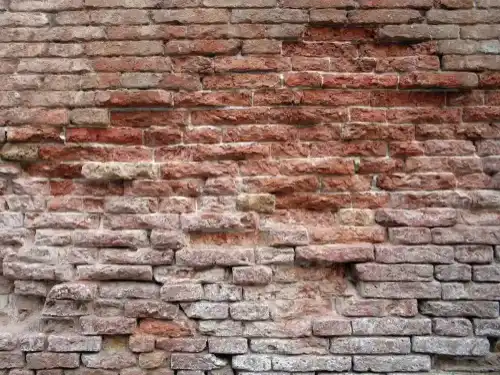
It’s also prone to cracking, leaning, and movement by both the weight of the home and outside soil pressure, especially when the soil gets saturated with no perimeter drain installed.
What do master home inspectors say about brick foundation maintenance
A dehumidifier will be your best friend and is a standard issue item in your brick basement. If your brick basement doesn’t have one, get one. If your new home has a brick foundation, buy one, run it to your floor drain or outside the home, and keep it running 24/7. This will suck up the moisture in the air and keep it from smelling – and feeling – damp.
And keep your storage items off the floor.
Because of the age of most brick foundation types and the porous nature of the materials, if you find one with no cracking, shifting, or bulging; pat yourself on the back. You’ve found a needle in a haystack.
All that’s left to do is clean and tuck-point areas when they show signs of wear.
If there is seepage and moisture (which is normal), clean your gutters, extend downspouts, sloping the ground away from the foundation, and consider installing a sump pump, exterior perimeter drain, or both.
If you install a perimeter drain, be sure to take extra special care not to damage the exposed foundation when putting the dirt back (these are areas that haven’t seen the light of day in over 100 years).
While you have it exposed, repair and seal the exterior foundation to protect it against future moisture and movement and line the trench with a drain cloth (avoid wrapping the drain in a sock).
If there is major shifting and movement, you can either reinforce the areas by installing a concrete pony wall in front – or – maybe opting for the bigger, more expensive, but (frankly) better long-term option of replacing the foundation.
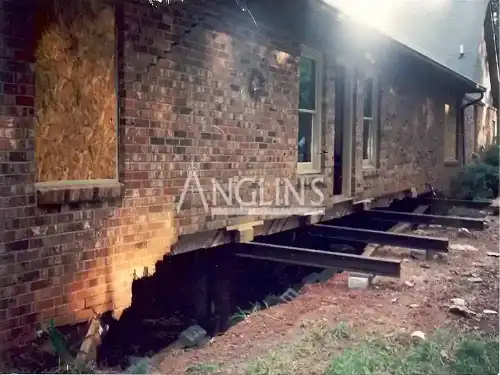
Despite being a $30k-$50k repair, replacement might be a better solution because the brick will continue to deteriorate behind the support wall.
And since the support wall is not designed to bear any of the home’s weight, future movement is likely.
Also, a new foundation will include a footing that will better distribute the weight of the home.
Brick foundation movement
If there is MAJOR movement in a brick foundation, your best bet is to call a professional structural engineer to provide insight on what’s happening and how to fix it.

Brick foundation tpes are not easy to repair (in fact, professionals sometimes disagree on what to do).
Normal cracking, deterioration, and movement can be handled by you or a foundation company.
But a structural engineer will not only tell you what what’s happening and how to fix it, they’ll create a report you can take to a foundation company, so they can do it right the first time.
Should You Finish Your Brick (or any old) Basement?

Maybe. But resist the urge to do it too soon or you may regret it later. Here’s why…
If you imagine daily life 100 years ago, basements were not intended – or used – as a comfortable living space (prohibition speakeasys aside – hiccup).
Otherwise, they were mainly used for storage, mechanicals (HVAC and plumbing), electrical components, and a refuge from harsh weather (this is Tornado alley, after all).
So, if you’re thinking about finishing your brick basement, I have two pieces of advice based on thousands of foundations inspected in all weather conditions and every season Kansas City has to offer over a 20-year home inspection career:
#1 – WAIT. And wait AT LEAST 12 months.
Waiting a year gives you a chance to see how your basement performs through all the seasons. You’ll find out:
- If the sellers really meant it when they said the basement was dry (just being honest)
- Where the moisture comes in
- How badly the water comes in (and possibly mud)
- When it comes in (sometimes it’s only during heavy rain or long period of rain)
- And most important of all, why it comes in
This will tell you what kind of repairs should be made BEFORE you cover the walls so you’re not suffering through a basement full of mold or demolishing your investment so commercial fans and dehumidifiers can be hauled in to dry out the damage areas.
Even then, your basement will always need regular maintenance to keep things dry so expect to leave enough space for movement behind the new walls.
#2 – Take BEFORE photos.
As you know, old basements were never meant to be finished or comfortable.
The exterior wasn’t sealed to keep moisture out, foundation drains weren’t used to keep hydrostatic pressure off the foundation by diverting water around the home, and the porous and brittle nature of bricks and mortar requires committed maintenance.
And when it’s your time to sell your home, your buyers (and if not, their home inspector) will know this, too.
So, when they walk into your Magnum Opus (thank you for the words, Isaac!), all that work might cast doubt if they think something sinister could be hiding behind those shiny new surfaces.
Take 5 minutes to shoot a ton of photos of every single area that could be concealed so eventually you’ll have more than enough to satisfy even the most skeptical person who might want to buy your home.
Trust me. This will pay dividends when the time comes.
Brick foundation repairs
How do you repair a brick foundation?
Start with the easy things first.
So, before you make major repairs, do some maintenance to make sure you clear up the cause before you address the symptoms.
If your walls have normal settlement cracking, deterioration, and seepage, tuck-point and parge the surface (skim coat of cement) to help keep the moisture out and create tatle-tale signs for the future. By the way, welcome to old home ownership 💪🏽.
If you see major shifting, bulging, crumbling beyond that, call a structural engineer.
1. Tuck pointing (repointing)
Used for normal deterioration and foundation cracks. Remove old mortar, clean the area, then fill the gaps with new mortar. Requires regular upkeep in moist areas.
Expected lifespan: 25-30 years
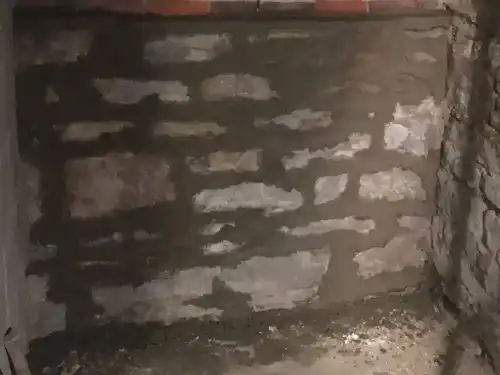
2. Vertical wall braces
This is usually made up of 4-inch I-beams placed vertically against the foundation ever 5-6 feet. The bottom is anchored into concrete and the top is bolted to floor joists. Expected lifespan: 20-30 years.
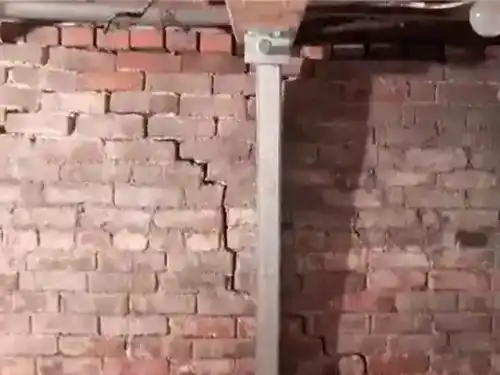
3. Pony wall
Also known as knee wall or cripple wall. This is a short, poured concrete or cinder block wall used to support a compromised foundation wall. Usually used in brick, stone, and cinder block foundation types.
Expected lifespan: 100-150 years

4. Polyurethane spray foam
Normally used as an easy and inexpensive substitute for epoxy resin. Comes in a can and quick to apply in an emergency.
Expected lifespan: 10-20 years

5. Support piers
Vertical structural supports buried in the ground beneath the foundation. They’re invisible after they’re installed.
Expected lifespan: 50+ years

Average cost of brick foundation repairs
| Type of Repair | Average Cost |
|---|---|
| Support piers | $1000 each |
| Tuck-pointing | $250-$300 / 100 sq.ft |
| Polyurethane spray foam | $40-$8400 / 1k sq.ft. |
| Pony wall | $10-$20 / lin. ft. |
| Vertical support wall braces | $400-$800 per brace |
Stacked Stone Foundation Types

What is a stacked stone foundation made from?
Limestone or rubble.
These foundation types were usually built by stacking two 8-inch walls (or wythes) side-by-side with a 4-inch gap in between. The space was filled with mortar then the outside was tuck-pointed to seal the openings.
When were stone foundation types used?
This is one of the earliest foundation types and goes back thousands of years. It was used extensively in the Kansas City area until about 1940.
How long should a stone foundation last?
100s of years with good, regular maintenance.
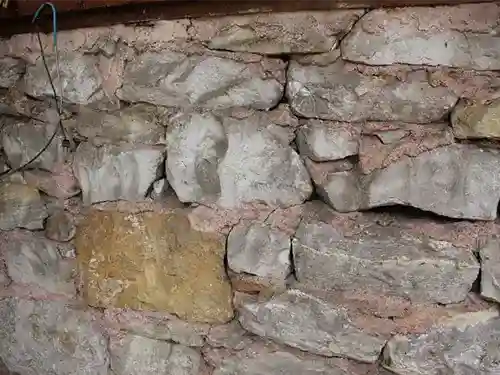
What can I expect if I have a stone foundation?
Don’t expect a dry basement.
Just like brick foundation tpes, this is a labor of love.
This is a beautiful material but also porous and prone to seepage as age and neglect allow the stone and mortar to let moisture through the gaps and worn areas.
You can also expect cracking, shifting, and movement if regular maintenance is not performed.
Should I finish my stone basement?
The concerns, considerations, and risks of finishing a stone foundation are the same as finishing a brick basement.
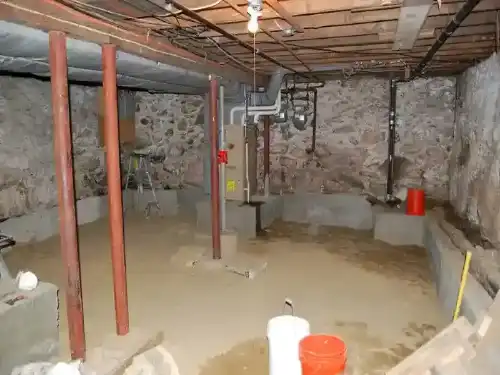
What do master home inspectors say about stone foundation maintenance
Regular maintenance is a part of everyday life when you own an old home.
And just like a brick foundation, a large dehumidifier that empties into a floor drain – or outside the home – will be a standing order in your stone basement.
In fact, ongoing maintenance for stone foundation types is the same as brick. Watch for spalling (flaking and deterioration), cracking, and movement.
Tuckpoint the areas that are flaking and deteriorated.
Good, consistent maintenance is how your stone foundation stays dry, solid, and lasts a lifetime.
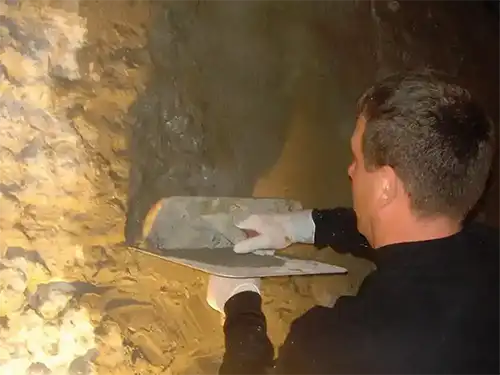
If moisture is seeping through an area, slope the ground away from the foundation, clean the gutters, extend downspouts, parge (cement skim coat) the area, and think about installing a sump pump to pump the water out.
Last but not least, keep your storage items off the floor.
Stone foundation movement
Some movement in stone foundations are normal, some are not.
Small to moderate vertical and diagonal cracks are normal (especially at the corner of door frame and window frames) and can be repaired by you or a professional foundation company if it’s beyond your ability.
If there is MAJOR movement in a stone foundation, your best move is to call a professional structural engineer (PE) to tell you what’s happening and how to fix it.
Major shifting, displacement, bulging, and horizontal cracking might mean the foundation is failing and you’ll need the expertise of a professional structural engineer.
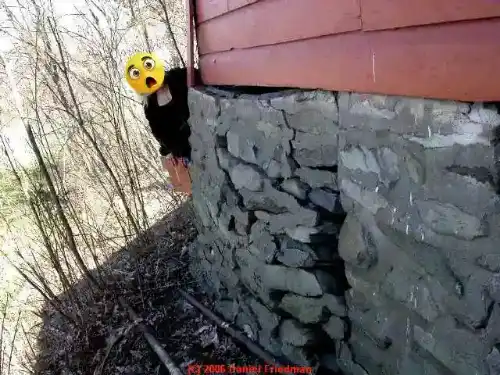
When To Call A Structural Engineer
Sometimes the problem is TOO MUCH for a contractor and sometimes it’s NOT ENOUGH a structural engineer.
Who should you call and when?
#1 Call a contractor when it is normal:
Types of foundation issues that can be diagnosed and repaired by a contractor:
- Vertical cracks < 1/4″ wide
- Diagonal cracks < 1/4″ wide
- Moisture seepage
- Neglect and maintenance
- Deterioration and spalling
- Crumbling stone
- Efflorescence
- Floor cracks
Other structural problems that can also be addressed by a contractor:
- Replace damaged posts and columns.
- Install missing posts and columns.
- Rebuild a retaining wall.
- Leaning retaining wall NOT affecting the home
#2 Call a structural engineer when it is not normal:
In other words, the problem has the potential to inflict major structural damage to the home.
A structural engineer has the technical expertise to look at a structural issue, put it in context, weigh the variables, troubleshoot the cause, then produce a specific recommendation to permenantly repair the problem.
Structural engineer-worthy foundation issues:
- Horizontal cracking
- Bulging foundation
- Leaning foundation
- Large vertical cracks (>3/4″)
- Large diagonal cracks (>3/4″)
- Active foundation movement
- Moisture seepage coming into the basement.
Many structural engineering concerns revolve around foundation problems, but not always. You should also call a structural engineer if you see something that worries you:
- Cracking support beam
- Dropping floors
- Crooked door frames and window frames
- Cracking smack dab in the middle of a wall
“The Structural Engineer Told Me What to Do. Now What?”
Now call the contractor to do the work.
The engineer’s report will contain a schematic and guidelines explaining:
- What the problem is
- What it takes to fix
- Size of any beams, piers, beams, columns, or posts
- How many to use
- Where to put them
These are the directions the contractor will follow to make sure the repairs are done right the first time.
Safeguard all the paperwork. You’ll need them when you sell the home.
“Why Shouldn’t I Just Call A Contractor to Come Fix the Issue?”
They are a technician trained to design, install, troubleshoot, and repair basic problems within their work.
But when there are outside forces acting on it, the repair requires someone who is not only trained to understand the forces, but also the limits of the materials being affected.
If you skip the engineer and go straight to a contractor, you run the very real chance they will either over-repair the problem or under-repair the problem.
Either way, it’s wrong and potentially more expensive.
When it’s time for you to sell the home, your buyer (or their home inspector) will want to know:
- Why did the area need to be repaired?
- What exactly was done?
- How do you know the repairs are correct?
- When were they done?
- Who did you use?
These questions are answered through the technical reports, scope of work, invoices, receipts.
Skipping the structural engineer for any major structural issue only creates problems down the road if it turns out the contractor was guessing and the repair needs to be redone.
“Is It Complicated Or Expensive To Call A Structual Engineer?”
Not at all. Especially when you consider the return on your investment.
There are PE‘s (Professional Engineers) and Structural Engineering firms all over Kansas City that specialize in structural issues of residential homes. You can expect to invest about $300-$350.
Stone foundation repairs
How do you make repairs to a stone foundation?
Start with the cheap and easy things first.
Do the routine maintenance items then tuck-point and parge (skim coat of cement) the cracks and keep out moisture.
Call a foundation company when tasks get too big or beyond your ability.
And if you start to see major shifting, bulging, cracking, crumbling, invest in a structural engineer to find out what’s happening BEFORE the movement damages the home.
1. Tuck pointing
Used on normal foundation cracks. With this, you remove deteriorated mortar, clean the area, then fill in gaps with fresh mortar. Normally lasts 25-30 years but may require more frequent upkeep in moist areas.
Expected lifespan: 25-30 years
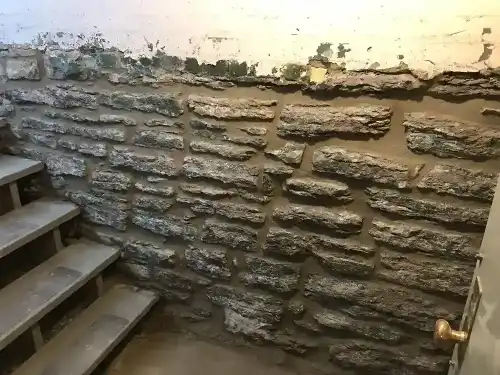
2. Pony wall
Also known as knee wall or cripple wall. This is a short, poured concrete or cinder block wall used to support a compromised foundation wall. Usually used in brick, stone, and cinder block foundation tpes.
Expected lifespan: 100-150 years
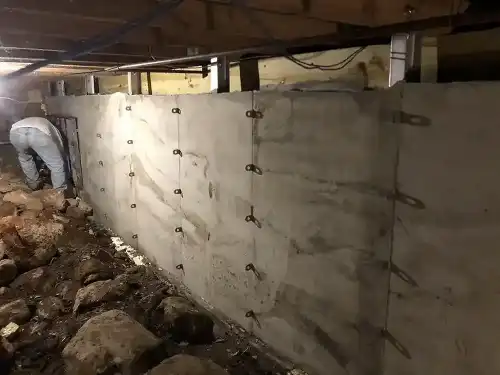
3. Polyurethane spray foam
Normally used as an easy and inexpensive substitute for epoxy resin. Comes in a can and quick to apply in an emergency.
Expected lifespan: 10-20 years

4. Support piers
Vertical structural supports buried in the ground beneath the foundation. They’re invisible after they’re installed.
Expected lifespan: 50+ years

Average cost of stacked stone foundation repairs
| Type of Repair | Average Cost |
|---|---|
| Support piers | $1000 each |
| Tuck-pointing | $250-$1500 for 100 sq.ft |
| Polyurethane spray foam | $40-$8400 for 1k sq.ft. |
| Pony wall | $10 – $20 / lin. ft. |
Concrete Block Foundation Types

What is a concrete cinder block foundation made from?
Pre-built concrete blocks reinforced with steel rebar.
When did cinder block foundations appear in Kansas City?
They gained traction in the 1940s and continue to be used today.
How long should a concrete block foundation last?
Concrete block foundation types are designed to last 80 to 100 years.
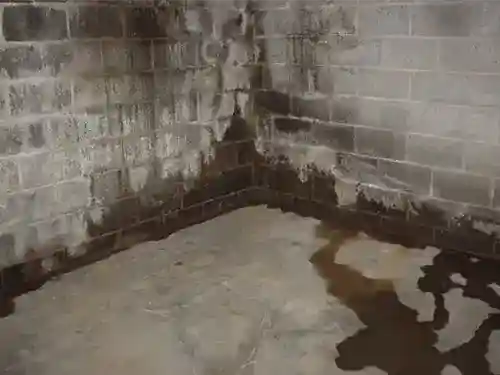
What can I expect from a cinder block foundation?
Believe it or not, block foundation types have better compression strength than poured concrete (weight-bearing capacity), but have weaker lateral strength (take less force to be pushed in).
Because block foundations are weakened by grout lines, they’re also more likely to bulge and crack than poured concrete. And since they require skilled masons to repair and rebuild, major repairs are more expensive than poured concrete.
Deteriorated grout lines also cause this foundation to leak water easier than poured concrete.
Many basements and crawlspaces in Kansas City are still made out of concrete block.
What do master home inspectors say about concrete block foundation maintenance

As we get into concrete foundation types, the need for a dehumidifier lessens, but these are still stacked blocks with weak joints that will crack, deteriorate, and seep so it’s still a good idea to have a dehumidifier running in the basements to keep the moisture down.
Concrete block foundations don’t crumble like stone or brick, so maintenance mainly revolves around moisture and movement:
1. Keep the outside dirt sloped away from the foundation.
2. Keep gutters clean.
3. Keep downspouts extended at least 6 feet away from the home.
4. Don’t let your sump pump drain empty near foundation
4. Keep storage items away off the floor and away from foundation.
5. Install a sump pump where seepage happens.
6. Seal the foundation – inside and out – as soon as seepage occurs.
If the block foundation cracks:
1.Tuck point the crack – inside and outside – as soon as they happen
2. If it’s larger than 1/4″, have it fixed by a foundation company
3. If it keeps growing, call a structural engineer
3. If it’s horizontal crack, call a structural engineer because the foundation could be caving in
Cinder block foundation movement
Step cracking, vertical cracks, diagonal cracks, and moisture seepage are just parts of living with a block foundation.
When this is manageable, either you or a foundation company can make the repairs.
But when things start making moves so big you start to wonder if they’ll move out and get a job, you need more than basic repairs.
It’s time for in-depth answers to complex problems that only a structural engineer can solve to keep your foundation from becoming an unwelcome pest.

4 Ways To Check If A Foundation Crack Is Still Moving
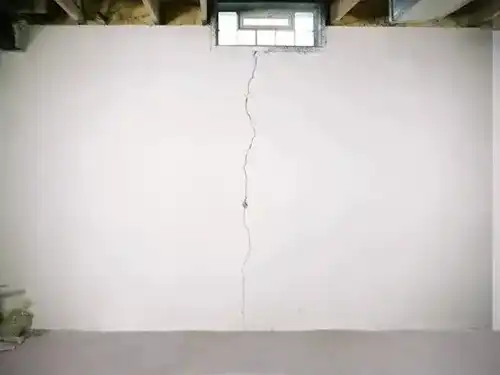
It’s impossible to know if a crack is still moving during the home inspection, especially if the home is vacant.
And if the crack doesn’t worry you, but you’re still curious if it’s moving, you’ve got to measure the crack over time.
There are several ways to tell if a foundation crack is still moving:
#1 Crack Gauge
A very cool tool. Simply put it across the crack, wait, and watch. The marks tell you how much it moves and how long it took to get there.
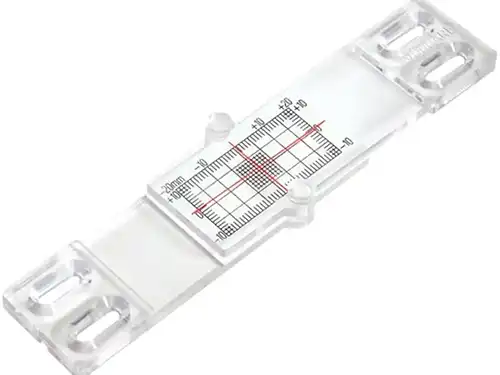
For drywall and plaster, patch the cracks as usual and watch for any new cracks to form.
Concrete block foundation repairs
How do you make repairs to a concrete block foundation?
I always recommend by starting with the quick and simple things first.
like everyday routine maintenance.
You can also fix minor seepage, spalling, flaking, and cracking.
But if things get spooky and you notice major shifting, bulging, cracking, and crumbling, you know who to call (no, not them 👻).
1. Vertical wall braces
This is usually made up of 4-inch I-beams placed vertically against the foundation ever 5-6 feet. The bottom is anchored into concrete and the top is bolted to floor joists. Expected lifespan: 20-30 years.

2. Tuckpointing (repointing)
Used on normal foundation cracks. Remove deteriorated mortar, clean the area, then fill in gaps with fresh mortar. Normally lasts 25-30 years but may require more frequent upkeep in moist areas.
Expected lifespan: 25-30 years
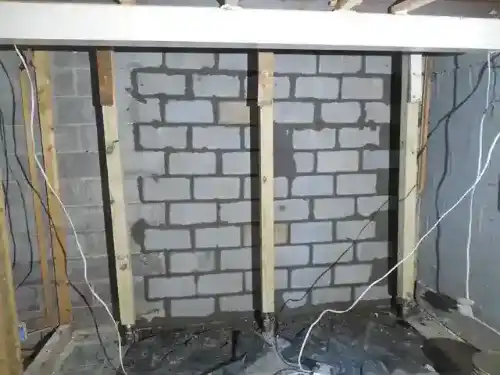
3. Pony wall (kneewall)
Also known as knee wall or cripple wall. This is a short, poured concrete or cinder block wall used to support a compromised foundation wall. Usually used in brick, stone, and cinder block foundation types.
Expected lifespan: 100-150 years

4. Dead man bracing (aka Tie-backs)
A wall plate attaches the foundation wall to heavy anchors buried in the ground outside the home.
Expected lifespan: 20-30 years

5. Support Piers
Vertical structural supports buried in the ground beneath the foundation. They’re invisible after they’re installed.
Expected lifespan: 50+ years
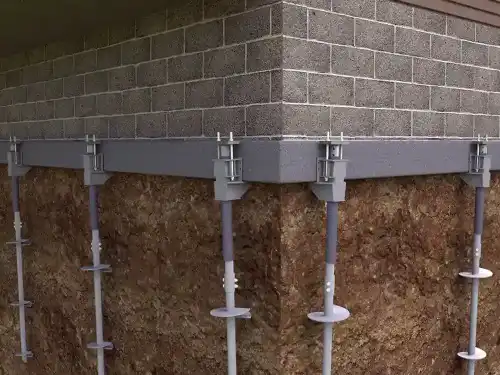
6. Polyurethane spray foam
Normally used as an easy and inexpensive substitute for epoxy resin. Comes in a can and quick to apply in an emergency.
Expected lifespan: 10-20 years
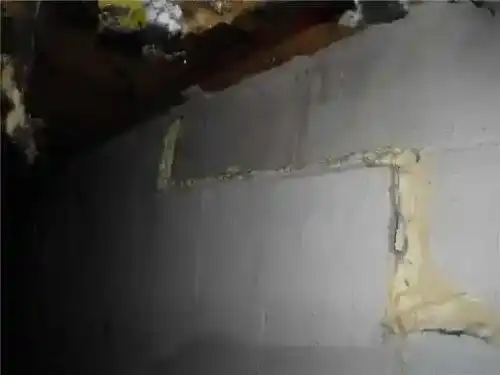
Average cost of concrete block foundation repairs
| Type of Repair | Average Cost |
|---|---|
| Vertical support wall braces | $400-$800 per beam |
| Dead man bracing (aka Tie-backs) | $1400-$2000 each |
| Support piers | $1000 each |
| Pony Wall | $10 – $20 / lin. ft. |
| Tuck-pointing | $250-$1500 for 100 sq.ft |
| Polyurethane spray foam | $40-$8400 for 1k sq.ft. |
Concrete Slab Foundation Types
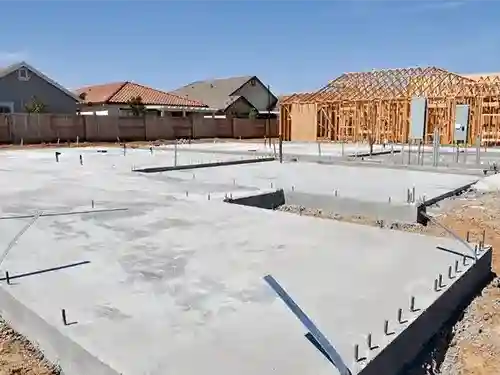
What is a concrete slab foundation made from?
This is a foundation made from a 6″-8″ concrete slab that sits directly on the ground. It has thickened footings at the edges and beneath load bearing walls.
When were concrete slab foundation types used?
Starting in the 1950s and continues to be used today.
How long should a concrete slab foundation last?
Usually, 80 to 100 years under normal conditions.
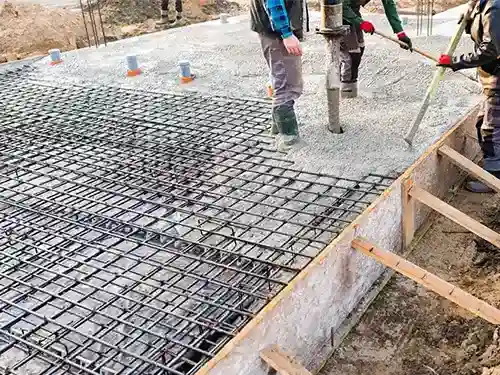
What can I expect if I have a concrete slab foundation?
1) Wall cracks, ceiling cracks, and uneven floors if it’s NOT maintained or built well.
And because it sits on the ground, cracked floors can let moisture seep in and damage flooring and personal items.
2) Difficult repairs to gas, water, electrical, and HVAC components.
One of the biggest downsides to slab foundation types is lack of space for mechanical and electrical lines, so they get embedded in the foundation.
So, in order to perform in-depth or intrusive updates, maintenance, or repairs, you’ll have to break open the concrete slab foundation.
3) Floor Heaving
During freezing temperatures, the moisture in the soil has the strength to lift the slab.
That’s why slab foundations are poured on top of a drainage layer of sand or gravel. These channel water away from the slab so there’s not enough to freeze, push, and crack the slab.
What do master home inspectors say about concrete slab foundation maintenance?
Concrete slab maintenance is pretty basic.
And it revolves around keeping the soil healthy, so the slab doesn’t move.
This is done by:
- Watering your yard
- Sloping dirt away from the foundation
- Don’t plant trees too close
- Extending downspouts away from foundation
- Installing root barrier
- Avoiding underground plumbing leaks
- Keeping gutters clean
Concrete slab foundation movement
In fact, cracking and movement are the biggest drawbacks in concrete slab foundation types and it happens for several reasons:
- Grading erosion
- Landscaping
- Saturated soil
- Dry soil
- Frozen soil
- Tree roots
- Construction vibration
- Nearby traffic
Watch for uneven floors and moisture, especially along the inside perimeter of the home.
In the case of a badly uneven floor, it might need to be levelled using support piers installed under the concrete slab.

Concrete slab foundation repairs
How do you make repairs to a concrete block foundation?
I always say start with the quick and simple things first.
Catch up on routine maintenance to make sure any repairs you have to make aren’t undone by ongoing erosion or movement.
And since there’s no space to work and nothing to see, there’s not much you can do.
If it’s not regular maintenance, you’ll likely have to call a professional to repair any major movement and moisture seepage you find.
And these are the common repairs to concrete slab foundation:
1. Foam jacking
Expanding foam is injected beneath the slab and lifts it up until it’s level. Quick and easy but check your sewer lines first.
Expected lifespan: 10-20 years
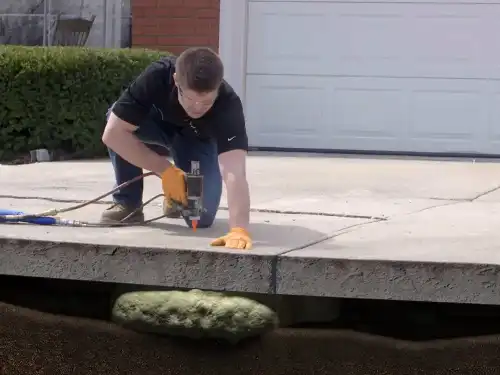
2. Hydraulic cement
Used to seal normal settlement cracks. Dries fast to stop water from coming into the home.
Expected lifespan: 2 years
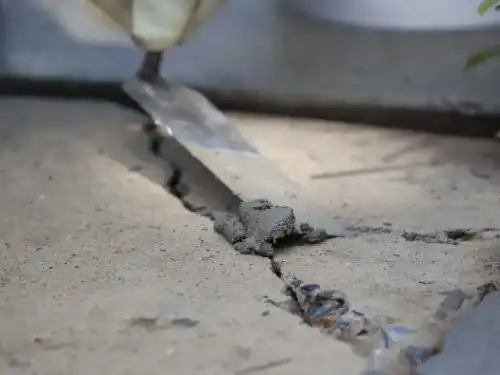
3. Epoxy resin
For larger structural cracks. Mix it and inject it into the crack. A good, permanent repair when the crack is vertical or diagonal.
Expected lifespan: 50+ years
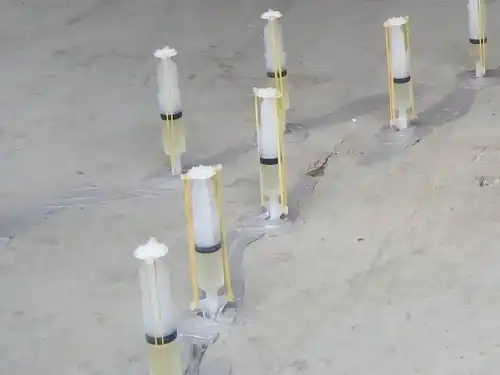
4. Support piers
Placed beneath the home to correct major movement in the floor and foundation. There are different types of piers for different situations.
Expected lifespan: 50+ years
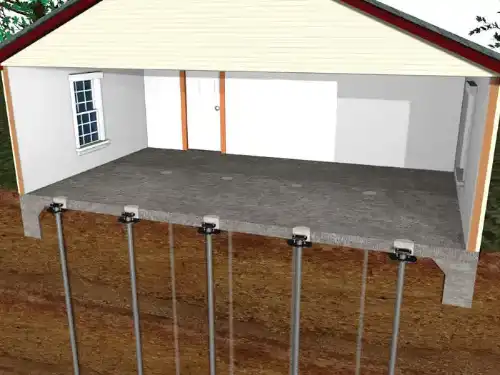
5. Polyurethane spray foam
Normally used as an easy and inexpensive substitute for epoxy resin. Comes in a can and quick to apply in an emergency.
Expected lifespan: 10-20 years
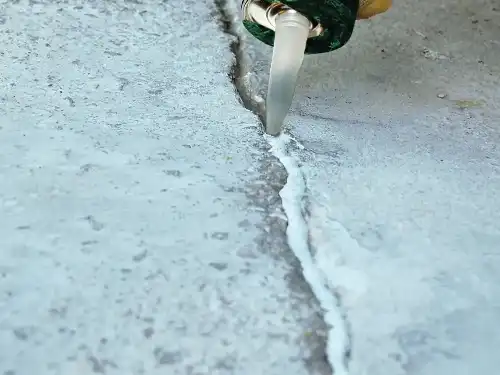
Average cost of concrete slab foundation repairs
| Type of Repair | Average Cost |
|---|---|
| Foam jacking | $5-$25 / sq.ft. |
| Support piers | $1000 each |
| Epoxy resin | $250-$800 per crack |
| Hydraulic cement | $250-$1500 for 100 sq.ft |
| Polyurethane spray foam | $40-$8400 for 1k sq.ft. |
So, what is the difference between mortar and hydraulic cement?
Mortar and hydraulic cement are both used in construction, but they have some differences.
In other words, mortar is used to stick things together, while hydraulic cement is used to plug up and seal things up.
Poured Concrete Foundation Types

What is a poured concrete foundation made from?
Poured concrete foundation types are poured into forms and reinforced with steel rebar. Walls are usually 8-10 inches thick.
When did poured concrete foundations appear in Kansas City?
From 1912 to today. You don’t see many 100+ year old poured concrete foundations around Kansas City, but they do exist.
How long should a poured concrete foundation last?
Poured concrete foundation types should last around 150 years.
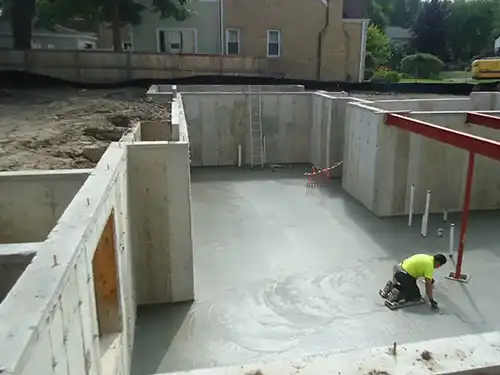
What can I expect from a poured concrete foundation?
Faster and more efficient to build than a concrete block foundation since it does not require the same level of skill in its craftsmen.
And with fewer joints, it’s also less likely to leak since and has better resistance to movement from soil pressure.
What do master home inspectors say about poured concrete foundation maintenance.
Poured concrete foundation types are more refined than cinder block but maintenance is just the same:
- Keep landscaping soil sloping away from the foundation.
- Keep gutters unclogged.
- Extend downspouts at least 6 feet away from the foundation.
- Install a sump pump in areas of seepage.
- Keep the sump pump drain at least 6 feet away from the foundation.
- If seepage happens, double check the above items and seal the foundation.
Types of poured concrete foundation movement.
You get 2 guarantees with concrete:
1) It will get hard
2) It will crack.
Most foundation cracks are normal, but if it keeps moving or outside forces break your poured concrete foundation, you’ll have to call professionals to troubleshoot and repair the damage.
#1 Small to medium (<1/4″) cracks.
Vertical and diagonal foundation cracks are NORMAL and can be repaired by a homeowner, handyman, or professional foundation repair company.
This is also true if the foundation crack lets water into the space. In this case, seal the crack INSIDE AND OUTSIDE the home.
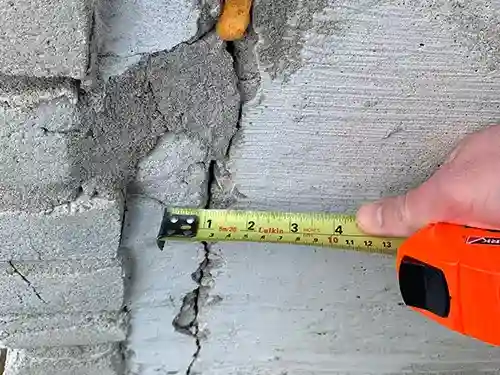

#2 Large (>1/4″) cracks.
Large vertical, diagonal, and horizontal foundation cracks are NOT NORMAL and mean there are excessive forces acting on the foundation that need to be understood before repairs can be made.
That’s why these types of cracks need to first be checked by a professional structural engineer so they stop moving and stop causing damage.

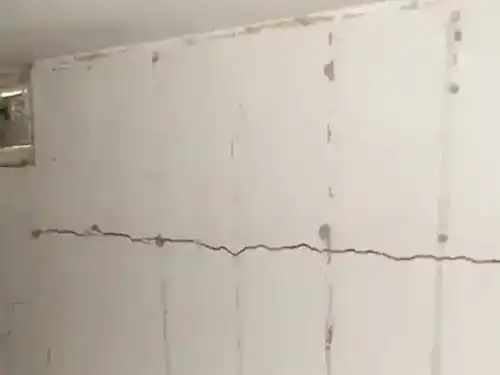
Huh? I Have a Crawlspace?
What you should know if you have one beneath your home.
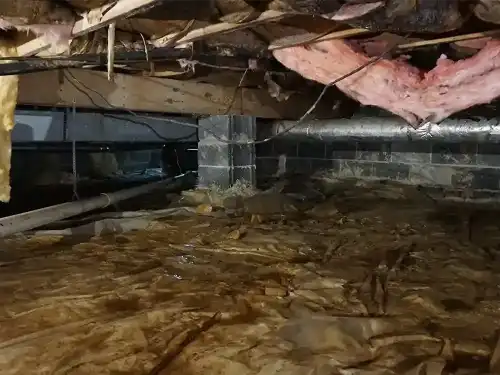
A crawlspace is a small, low area beneath the house. It’s not a basement, so you can’t usually stand up, but it’s used to access important systems like plumbing, electrical wires, and sometimes heating or cooling.
It’s also a space where home inspectors can check for issues and where important maintenance and repairs can be made.
Crawlspace walls are built from the same materials as a basement, so that maintenance will be the same, but instead of concrete, crawlspaces usually have a dirt floor.
And since it is said that 1,000 sq.ft. of exposed dirt floor can let as much as 12 gallons of water vapor into the average crawlspace per day, ventilation and moisture control is a BIG FACTOR and one of the biggest differences between a crawlspace and a basement.
Moisture and your crawlspace
Before there was building science, it was believed we should leave our crawlspace vents open so the air under our home can escape.
Next, they told us to leave our crawlspace vents open in summer and closed in winter.
But, in 2009 a crawlspace moisture study conducted by a group called Advanced Energy discovered that we should leave our crawlspace vents closed all year round.
What about the 100lbs. of moisture that comes into my crawlspace every day?
Simple. Install a vapor barrier.
A vapor barrier is a big sheet of plastic (usually black 6ml) or other material that covers the dirt floor and stops moisture from seeping into the crawlspace.
Once the plastic is installed over the crawlspace floor, it’s covered with a layer of gravel or sand.
Don’t Forget!
Since we’re talking about moisture in the air, it’s also a good idea to keep a dehumidifier running in your crawlspace to act as an added layer of moisture protection.

Average cost of crawlspace vapor barrier
| Vapor barrier | $1.35 – $2 / sq.ft |
Types of poured concrete foundation repairs
I always recommend starting with the quick and simple things first.
Catch up on routine maintenance so if nothing else, your repairs won’t be bothered or undone by something quick and easy later.
And when your poured concrete foundation suffers from MAJOR MOVEMENT in the floor or walls, expect to call a local structural engineer to figure out WHAT needs to be done. Then a call to your favorite foundation repair company to do it.
So, what types of repairs could they recommend – and perform – on your poured concrete foundation?
1. Vertical support wall braces
This is usually made up of 4-inch I-beams placed vertically against the foundation ever 5-6 feet. The bottom is anchored into concrete and the top is bolted to floor joists. Expected lifespan: 20-30 years.

2. Dead man bracing (aka Tie-backs)
A wall plate attaches the foundation wall to heavy anchors buried in the ground outside the home.
Expected lifespan: 20-30 years
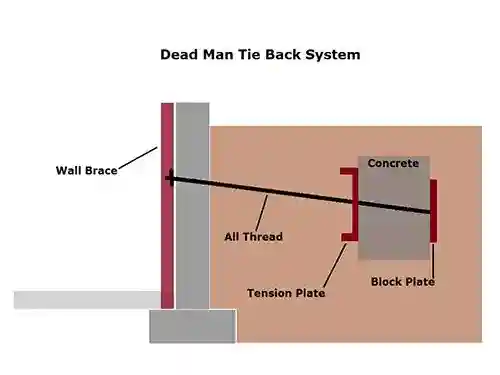
3. Support piers
Vertical structural supports buried in the ground beneath the foundation. They’re invisible after they’re installed.
Expected lifespan: 50+ years

4. Epoxy resin
A special adhesive used on large foundation cracks. It seals the crack and strengthens the foundation and lasts 10 years or more.
Expected lifespan: 10-20+ years
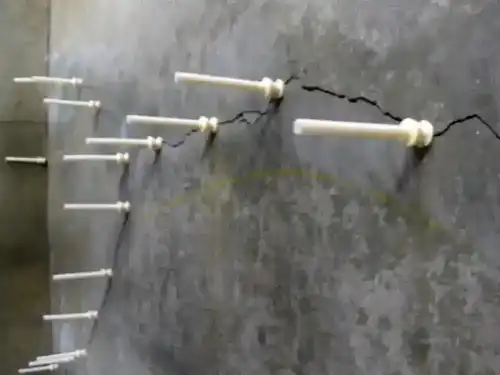
5. Tuck pointing
Used on normal foundation cracks. With this, you remove deteriorated mortar, clean the area, then fill in gaps with fresh mortar. Normally lasts 25-30 years but may require more frequent upkeep in moist areas.
Expected lifespan: 25-30 years
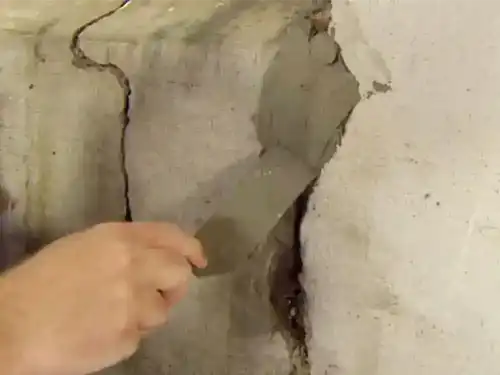
6. Polyurethane spray foam
Normally used as an easy and inexpensive substitute for epoxy resin. Comes in a can and quick to apply in an emergency.
Expected lifespan: 10-20 years

Average cost of poured concrete foundation repairs
| Type of Repair | Average Cost |
|---|---|
| Vertical support wall braces | $400-$800 per beam |
| Dead man bracing (aka Tie-backs) | $1400-$2000 each |
| Support piers | $1000 each |
| Epoxy Resin | $250-$800 per crack |
| Tuck-pointing | $250-$1500 for 100 sq.ft |
| Polyurethane spray foam | $40-$8400 for 1k sq.ft. |


